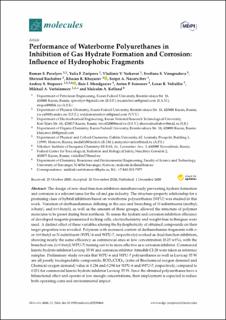| dc.contributor.author | Pavelyev, Roman S. | |
| dc.contributor.author | Zaripova, Yulia F. | |
| dc.contributor.author | Yarkovoi, Vladimir V. | |
| dc.contributor.author | Vinogradova, Svetlana S. | |
| dc.contributor.author | Razhabov, Sherzod | |
| dc.contributor.author | Khayarov, Khasan R. | |
| dc.contributor.author | Nazarychev, Sergei A. | |
| dc.contributor.author | Stoporev, Andrey S. | |
| dc.contributor.author | Mendgaziev, Rais I. | |
| dc.contributor.author | Semenov, Anton P. | |
| dc.contributor.author | Valiullin, Lenar R. | |
| dc.contributor.author | Varfolomeev, Mikhail A. | |
| dc.contributor.author | Kelland, Malcolm Andrew | |
| dc.date.accessioned | 2021-04-28T13:33:00Z | |
| dc.date.available | 2021-04-28T13:33:00Z | |
| dc.date.created | 2021-03-17T12:09:26Z | |
| dc.date.issued | 2020-12 | |
| dc.identifier.citation | Pavelyev, R.S., Zaripova, Y.F., Yarkovoi, V.V. et al. (2020) Performance of Waterborne Polyurethanes in Inhibition of Gas Hydrate Formation and Corrosion: Influence of Hydrophobic Fragments. Molecules, 25 (23), 1-18. | en_US |
| dc.identifier.issn | 1420-3049 | |
| dc.identifier.uri | https://hdl.handle.net/11250/2740220 | |
| dc.description.abstract | The design of new dual-function inhibitors simultaneously preventing hydrate formation and corrosion is a relevant issue for the oil and gas industry. The structure-property relationship for a promising class of hybrid inhibitors based on waterborne polyurethanes (WPU) was studied in this work. Variation of diethanolamines differing in the size and branching of N-substituents (methyl, n-butyl, and tert-butyl), as well as the amount of these groups, allowed the structure of polymer molecules to be preset during their synthesis. To assess the hydrate and corrosion inhibition efficiency of developed reagents pressurized rocking cells, electrochemistry and weight-loss techniques were used. A distinct effect of these variables altering the hydrophobicity of obtained compounds on their target properties was revealed. Polymers with increased content of diethanolamine fragments with n- or tert-butyl as N-substituent (WPU-6 and WPU-7, respectively) worked as dual-function inhibitors, showing nearly the same efficiency as commercial ones at low concentration (0.25 wt%), with the branched one (tert-butyl; WPU-7) turning out to be more effective as a corrosion inhibitor. Commercial kinetic hydrate inhibitor Luvicap 55 W and corrosion inhibitor Armohib CI-28 were taken as reference samples. Preliminary study reveals that WPU-6 and WPU-7 polyurethanes as well as Luvicap 55 W are all poorly biodegradable compounds; BODt/CODcr (ratio of Biochemical oxygen demand and Chemical oxygen demand) value is 0.234 and 0.294 for WPU-6 and WPU-7, respectively, compared to 0.251 for commercial kinetic hydrate inhibitor Luvicap 55 W. Since the obtained polyurethanes have a bifunctional effect and operate at low enough concentrations, their employment is expected to reduce both operating costs and environmental impact. | en_US |
| dc.language.iso | eng | en_US |
| dc.publisher | MDPI | en_US |
| dc.rights | Navngivelse 4.0 Internasjonal | * |
| dc.rights.uri | http://creativecommons.org/licenses/by/4.0/deed.no | * |
| dc.subject | waterborne polyurethane | en_US |
| dc.title | Performance of Waterborne Polyurethanes in Inhibition of Gas Hydrate Formation and Corrosion: Influence of Hydrophobic Fragments | en_US |
| dc.type | Peer reviewed | en_US |
| dc.type | Journal article | en_US |
| dc.description.version | publishedVersion | en_US |
| dc.rights.holder | © 2020 by the authors. | en_US |
| dc.subject.nsi | VDP::Matematikk og Naturvitenskap: 400::Kjemi: 440 | en_US |
| dc.source.pagenumber | 1-18 | en_US |
| dc.source.volume | 25 | en_US |
| dc.source.journal | Molecules | en_US |
| dc.source.issue | 23 | en_US |
| dc.identifier.doi | 10.3390/molecules25235664 | |
| dc.identifier.cristin | 1898617 | |
| dc.source.articlenumber | 5664 | en_US |
| cristin.ispublished | true | |
| cristin.fulltext | original | |
| cristin.qualitycode | 1 | |

